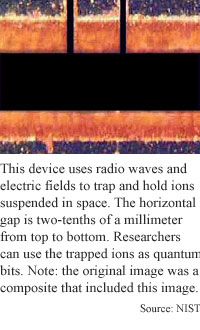
Quantum bit hangs tough
By Eric Smalley, Technology Research NewsEfforts aimed at building quantum computers face a common nemesis: noise.
The fragile arrangements of atoms and subatomic particles that make up today's rudimentary prototypes are easily disabled by small amounts of energy from the environment. Researchers at the National Institute of Standards and Technology (NIST) have built a quantum bit (qubit) that is immune to a key form of decoherence, or noise.
The Decoherence Free qubit can store a single bit's worth of information. It could also serve as the basic building block of a practical quantum computer.
The NIST team created the qubit in an ion trap, which is a device that uses radio waves and electric fields to suspend ions in space. The researchers trapped two beryllium ions and then used lasers to control how the ions were spinning and interacting with each other.
An atom or subatomic particle can serve as a qubit because it spins in one of two directions, which can represent the ones and zeros of binary computing. Quantum computers are potentially much more powerful than ordinary computers for certain applications because atoms and subatomic particles can exist in the quantum mechanical state of superposition in which they are essentially spinning in both directions at the same time. This allows a relatively small number of qubits to represent very large numbers.
The catch is that particles exist in quantum states for only tiny fractions of a second before decoherence sets in. Because a practical quantum computer will need to perform thousands of operations on its qubits, making them last is critical.
One way to make them last is to create Decoherence Free Subspaces (DFSs), which are essentially noise-free zones. When two or more physical qubits are subjected to the same noise, it's possible for a subset of their possible states to be immune to the noise. Researchers can use these protected states to create logical qubits.
The principal form of decoherence in the NIST ion trap is dephasing, which is the condition in which the ions' energy levels fluctuate randomly, said David Kielpinski, a research assistant at NIST.
"What we demonstrated in our paper was that there are these two states and they are resistant to collective dephasing, and any superposition of these two states is resistant to collective dephasing," he said. "That makes one qubit which is resistant to collective dephasing."
The researchers showed that the Decoherence Free qubit lasted about three times as long as an unprotected qubit.
"The work by the NIST group is a crucial step towards employing noise-free methods in quantum computation," said Paul Kwiat, a physics professor at University of Illinois.
In October, Kwiat and a team of researchers at Los Alamos National Laboratory reported the first experimental verification of DFSs. Their experiment involved two photons and yielded a single decoherence free state.
Though the NIST results are significant, a mere tripling of the qubit's very short lifetime is not sufficient by itself for practical computing, said Kwiat. "Any system that you eventually come up with will have some residual [noise] effects so that using these decoherence-free methods will never be the whole story," he said.
An alternative to DFSs are quantum error correction schemes, which essentially clean up errors introduced by decoherence. However, quantum error correction codes would require a lot of computer power. The ultimate answer will likely involve combining DFSs and quantum error correction, said Kwiat.
The NIST team's long-range plan is to build a practical quantum computer by linking many ion traps. "In our particular idea of how large-scale quantum computing would work, you want to be shuttling your qubits around over fairly big distances in space," said Kielpinski.
DFSs could play a key role because even though moving ions around in space subjects them to potentially destructive changes in the environmental energy, pairs of ions will experience the same changes and therefore could preserve DFSs.
It will likely be 20 years before quantum computing of any kind becomes practical, said Kielpinski.
Kielpinski's research colleagues were Volker Meyer, Mary A. Rowe, Cass A. Sackett, Wayne M. Itano and Dave J. Wineland of NIST, and Christopher Munro of the University of Michigan. They published the research in the January 4, 2000 issue of SciencExpress. The research was funded by the National Security Agency, the Office of Naval Research and the Army Research Office.
Timeline: 20 years
Funding: Government
TRN Categories: Quantum Computing
Story Type: News
Related Elements: Image; Technical paper, "A Decoherence-Free Quantum Memory Using Trapped Ions," SciencExpress, January 4, 2000
Advertisements:
January 17, 2001
Page One
Light spins resin rotors
Crossed nanowires make Lilliputian LEDs
Simulation sizes up Web structure
Quantum bit hangs tough
Sowing strain reaps ordered dots

News:
Research News Roundup
Research Watch blog
Features:
View from the High Ground Q&A
How It Works
RSS Feeds:
News
Ad links:
Buy an ad link
| Advertisements:
|
 |
Ad links: Clear History
Buy an ad link
|
TRN
Newswire and Headline Feeds for Web sites
|
© Copyright Technology Research News, LLC 2000-2006. All rights reserved.